7 Types of Blackbirds in Ohio (With Pictures)
Last Updated on
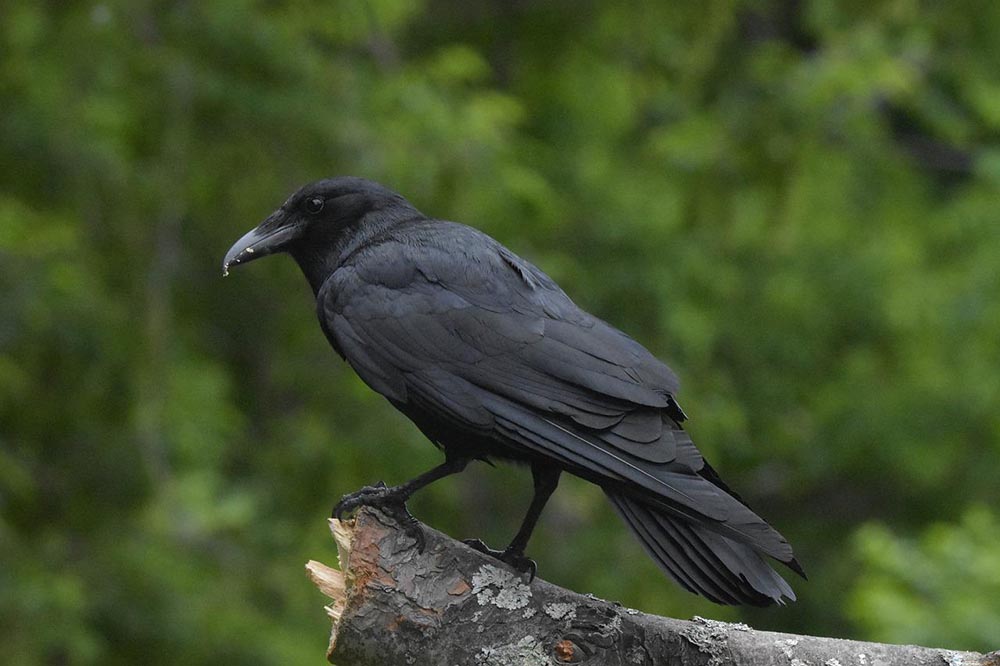
Ohio is home to some pretty interesting birds. There is a wide selection of birds in all shapes and colors. When it comes to blackbirds, just how many species does Ohio harbor, and what are some interesting facts about them? Don’t worry. We have all the basic information you could want to know about these fantastic creatures.

Top 7 Types of Blackbirds in Ohio:
1. American Crow

| Scientific Name: | Corvis brachrhynchos |
| Population: | 31 million |
The American crow is arguably the most interesting and misunderstood bird in Ohio. These animals are insanely intelligent, making the top 10 list every time for the smartest animals on the planet.
Diet
The American crow is an omnivore and sometimes feasts on carrion. These birds are opportunistic eaters and accept a wide range of diets. Their primary diet consists of spiders, insects, earthworms, frogs, smaller snakes, human garbage, eggs, grain and seed, berries, and fruit.
Environment
Crows tend to congregate together and open forests and around forest edges. They also gravitate towards urban areas where food sources are abundant.
Intelligence
Crows have an impeccable memory that does not compare to others. These birds have incredibly complex social structures and honestly look out for one another as a species. They even have a type of language and can teach their young extremely complicated concepts that they remember for their entire lives.
- Fun Fact: In studies, crows are considered as intelligent, if not more so than chimpanzees. They exhibit extreme problem-solving skills and complex social structures.
2. Red-winged Blackbird
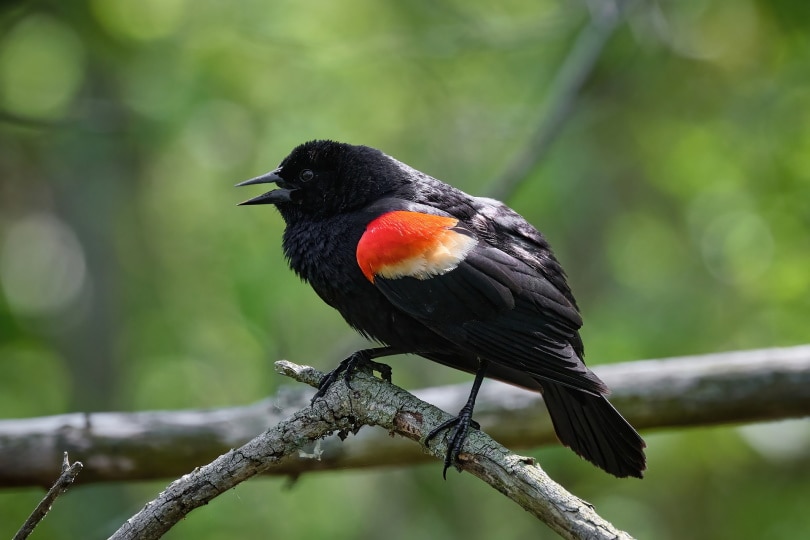
| Scientific Name: | Agelaius phoeniceus |
| Population: | 210 million |
You’ll quickly recognize the Red-winged Blackbird. These birds are very abundant in Ohio though they might also be confused with the oriole. Instead, these blackbirds have an orange patch on their shoulder area.
Diet
The Red-winged Blackbird feeds primarily on insects such as caterpillars, Beatles, crickets, grasshoppers, and others. They might also occasionally eat spiders, snails, and slugs. They also require grain in their diets, so you might see them snacking on grasses and weeds.
Breeding
The Red-winged Blackbird is always together with a flock, even during mating season. These birds stay neutral with one another, peacefully getting along in communal territory.
Environment
The Red-winged Blackbird typically enjoys unpopulated areas, and you might see them inhabiting places like marshes, swamps, hay fields, and foraging next to small water sources.
Intelligence
Red-winged blackbirds tend to be pretty territorial and not the friendliest of birds, especially during mating season.
- Fun Fact: Red-winged blackbirds are highly polygamous. One male has up to 15 female birds in a season.
3. European Starling
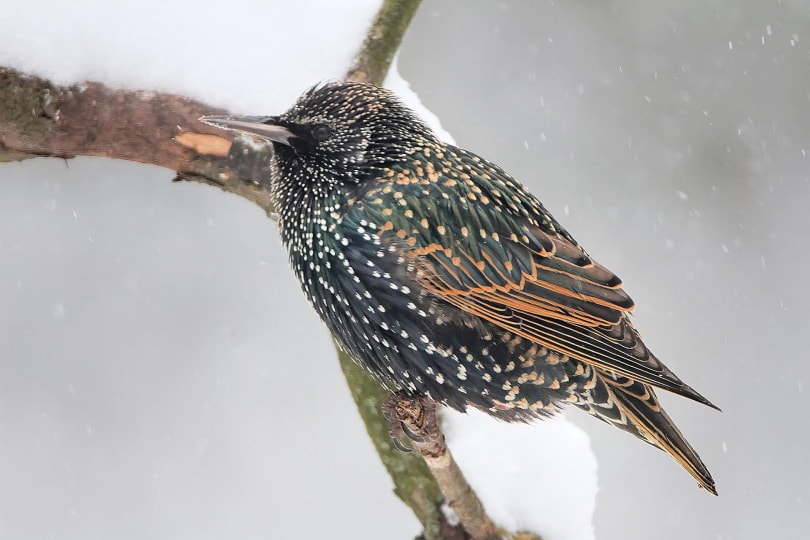
| Scientific Name: | Sturnus vulgaris |
| Population: | 200 million |
As the name implies, this starling comes from Europe. The European starling was actually introduced to Ohio quite some time ago. These birds obviously thrived in the state, as they are prevalent backyard birds.
Diet
The European Starling is mainly an insectivore, snacking on Beatles, grasshoppers, and other common yard insects. They also eat a variety of berries and fruits during the summer and fall months.
Environment
European starlings inhabit areas like cities, parks, farms, and other suburban areas. They enjoy nesting and manufactured items, so it’s not uncommon to find one nesting on your property.
Intelligence
European starlings are generally very intelligent birds, but they can also be very aggressive, it’s best to stay away from them during breeding season as males are notably aggressive and might even attack. For this reason, some consider them pests.
- Fun Fact: All American European Starlings spawned from a group of 100 birds released into New York City.
4. Common Grackle
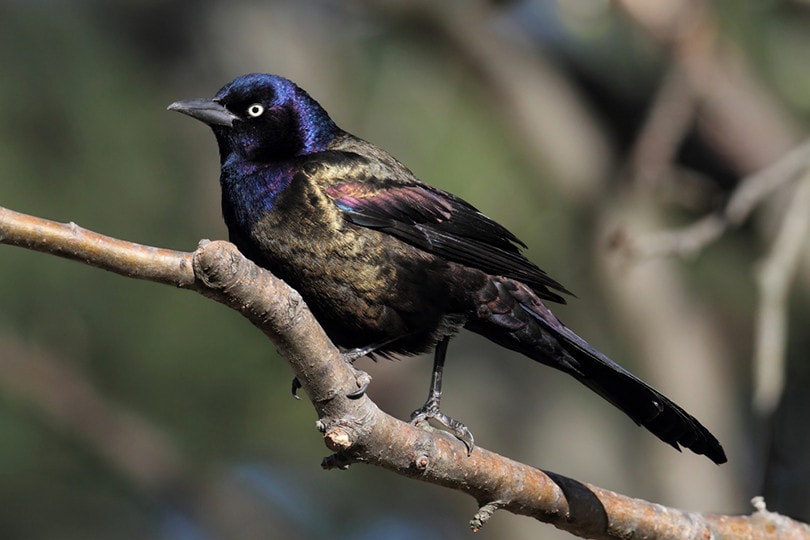
| Scientific Name: | Quiscalus quiscula |
| Population: | 67 million |
The untrained eye might mistake the common grackle for a crow as they are similar in structure and color. However, the grackle is smaller than the crow, with a blue hue on the head. These birds are known for their boisterous vocals. And while they are beautiful, they are a little bit territorial with smaller birds.
Diet
The common grackle eats a variety of insects and plants. They also love picking up food that humans have dropped and will often fight off other common backyard birds like Robins and Cardinals to steal food. Some grackles travel alone, but you usually see them together in a flock.
Environment
The common grackle prefers to live in man-made territories such as towns and farmland. But they also enjoy being in groves or by stream sides. They prefer a semi-rural area, and they love to forage and farm fields, lawn landscapes, and animal pastures.
Intelligence
While the common grackle shares an uncanny resemblance to crows and Ravens, they don’t share the exact same kind of intelligence. They are significantly less smart, although they are pretty clever in their own right.
- Fun Fact: Grackles will let ants cover their bodies to secrete formic acid that kills parasites on their bodies.
5. Rusty Blackbird
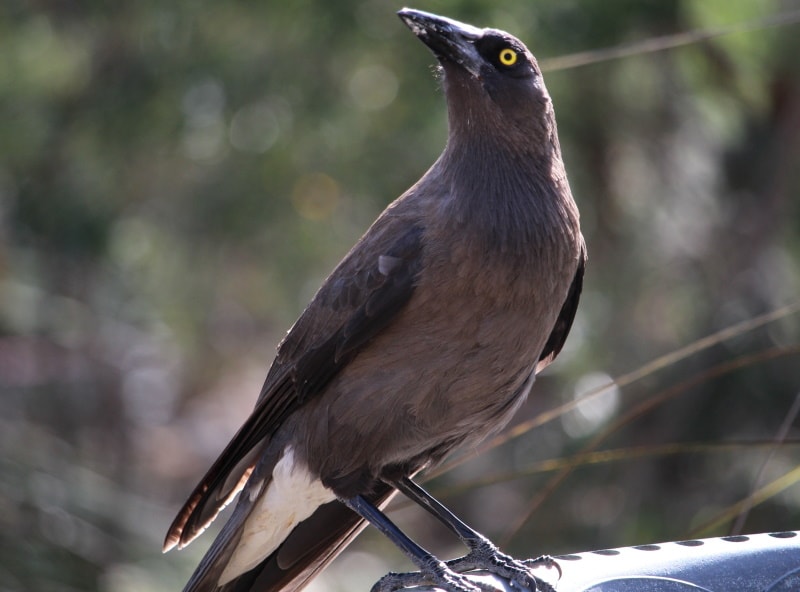
| Scientific Name: | Euphagus carolinus |
| Population: | 5 million |
It’s really easy to confuse the common black grackle for the rusty blackbird. They are very similar in size and body structure. However, if you see one in direct sunlight, you can tell apparent differences based on the color.
The Rusty blackbird has undergone a huge decline in population in North America. Scientists don’t exactly understand the reasons why yet, but they are dropping in drastic numbers.
Diet
The rusty blackbird tends to gravitate towards insects that hang out around water sources like dragonflies, caddisflies, mayflies, and water beetles. They also enjoy things on land like snails, salamanders, and grasshoppers. They also enjoy grains, especially seeds.
Environment
You might have recognized from their diet that these birds love to hang out around freshwater sources. They much prefer to be in areas like wooded swamps and river settings.
Intelligence
Like most other blackbirds, the rusty blackbird is generally very intelligent. However, this bird is very elusive to birdwatchers and scientists that study birds, so it’s hard to gauge their intelligence compared to other blackbirds. Also, singular rusty blackbirds may hang out in flocks of other blackbirds, so it’s easy for them to go unnoticed.
- Fun Fact: Rusty blackbirds can be pretty vicious. Some have been reported to attack and eat other birds like robins, snipes, and sparrows.
6. Yellow-headed Blackbird
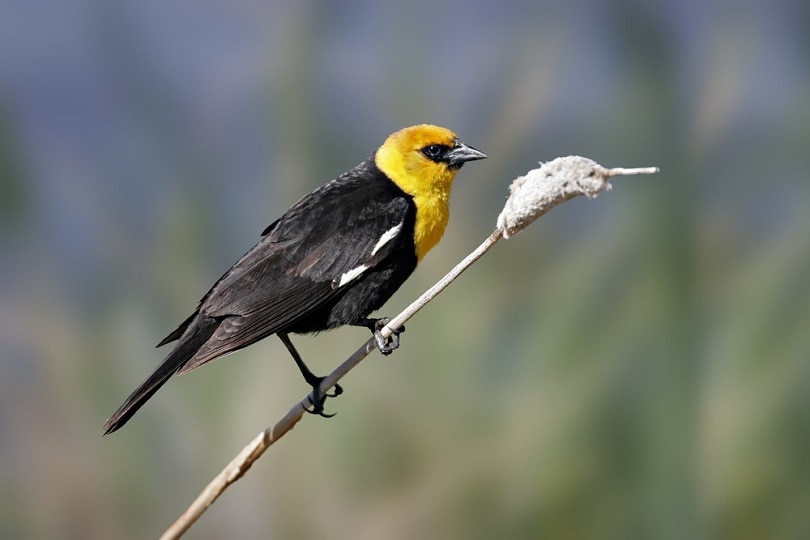
| Scientific Name: | Xanthocephalus Xanthocephalus |
| Population: | 23 million |
It might be hard to notice the yellow-headed blackbird without its beautiful yellow head, hence the name. It stands out bold among the environment, being quite a spectacle for onlookers. It’s a rare sight in Ohio—but you might get lucky.
Diet
Yellow-headed blackbirds actually have a perfect diet because they get rid of unwanted insects like Wasps, ants, and other common pests. They also love eating caterpillars, grasshoppers, and a variety of common seeds.
Environment
The Yellow-headed blackbird really loves marshes and wetlands. They thrive in areas with lots of incest, crustacean, and small fish habitat. These birds don’t permanently reside in Ohio—but it’s always a summer surprise when you do spot one hanging out on a cattail.
Intelligence
These blackbirds hoard together in flocks, but males during mating season can be extremely territorial. A single male can impregnate and rule the area of up to 16 females.
- Fun Fact: The male’s song is harsh, horrible, and would get booed off any talent show stage.
7. Brewer’s Blackbird
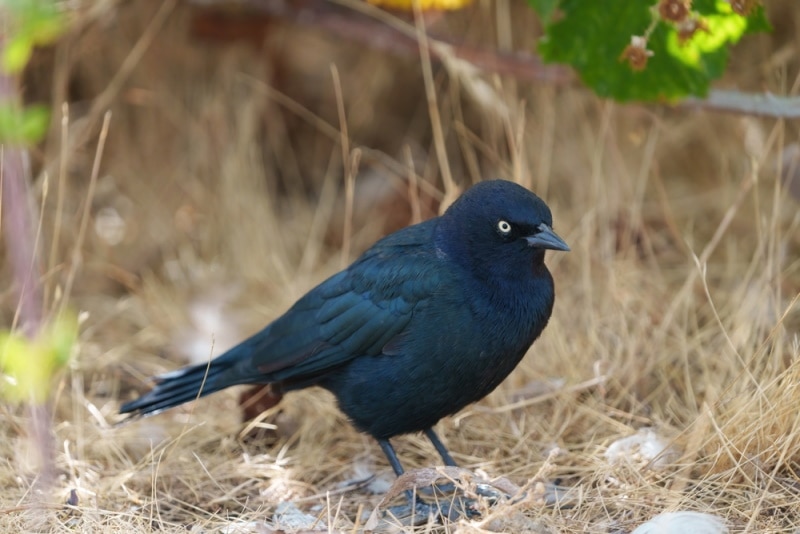
| Scientific Name: | Euphagus cyanocephalus |
| Population: | 23 million |
Brewer’s blackbirds are a rare sight in Ohio, but they still migrate to the area. Brewer’s blackbirds are incredibly glossy black with a slight iridescence to their feathers. They are medium-sized birds with alert eyes and quick actions.
Diet
Brewer’s blackbirds eat a variety of insects, including termites, spiders, beetles, caterpillars, and aphids. They are very good at removing common pests around the yard.
Environment
The Brewer’s Blackbird can thrive in both industrialized and rural areas. They frequent streamside forests, shores, farmland, mountain meadows, and prairies. They simply need the right access to food.
Intelligence
Brewer’s Blackbirds are interesting creatures with peculiar habits. For instance, females will build nests low in a shrub one year and high in a tall tree the next. They are highly social creatures and congregate in flocks.
- Fun Fact: The Brewer’s Blackbird is a monogamous bird for the most part, unlike its blackbird cousins.

Final Thoughts
So, now you have officially brushed up on your daily dose of bird knowledge. Ohio is home to some pretty beautiful birds and these black birds are unique in their own right. Not all of them are as smart as the largest on our list—the American Crow.
But each one of them has a complex social structure and gives the environment such a lovely aesthetic. We hope you learned something new today. Which of these black birds is your favorite?
Featured Image Credit: JackBulmer, Pixabay
About the Author Robert Sparks
Robert’s obsession with all things optical started early in life, when his optician father would bring home prototypes for Robert to play with. Nowadays, Robert is dedicated to helping others find the right optics for their needs. His hobbies include astronomy, astrophysics, and model building. Originally from Newark, NJ, he resides in Santa Fe, New Mexico, where the nighttime skies are filled with glittering stars.
Related Articles:
Monocular vs Telescope: Differences Explained (With Pictures)
10 Types of Hummingbirds in Arkansas (With Pictures)
8 Types of Hummingbirds in Nebraska (With Pictures)
5 Types of Hummingbirds in Idaho (With Pictures)
3 Types of Hummingbirds in Mississippi (With Pictures)
8 Types of Hummingbirds in Kansas (With Pictures)
5 Types of Hummingbirds in West Virginia (With Pictures)
5 Types of Hummingbirds in Ohio (With Pictures)
